Module
3
Lecture
3
Instructional objectives
By the end of this lecture, the students are expected to learn the working principle of bulk deformation processes and the factors to be considered in the selection and design of a bulk deformation process. Furthermore, how careful design can improve the quality of the final product is also highlighted.
What is Bulk Deformation?
Metal forming operations which cause significant shape change by plastic deformation in metallic parts are referred to bulk deformation processes. In most of the cases cylindrical bars and billets, rectangular billets and slabs, and similar shapes are the initial shapes which are plastically deformed in cold, warm or hot conditions into a desired shape. Complex shapes with good mechanical properties can be produced by bulk deformation processes. Following metal forming operations are commonly referred to as bulk deformation processes.
1. Forging – The initial shape is squeezed and shaped between two opposing dies. 2. Rolling – A slab or plate is squeezed between two rotating rolls to reduce the height
so as to produce thinner shapes like sheets,
3. Extrusion – The initial shape is squeezed through a shaped die such that the cross-section of the deformed part becomes similar to that of the die opening.
4. Wire and bar drawing – The diameter of typical cylindrical bars or wires is reduced by pulling it through a shaped die.
Forging
Forging is the process by which a metallic part is deformed to a final shape with the application of pressure and with or without the application of heat. Forging processes can broadly be classified as follows.
Open Die Forging
The workpiece is compressed between two flat dies facilitating lateral flow of material without constraint,
Impression Die Forging
Flashless Forging
This is an improved version of Impression-die forging process. The initial volume of the workpiece is carefully taken so that no excess flash is produced.
Figure 3.3.1 outlines the schematic set-up for the above three forging processes. Following are some of the major advantages of forging processes.
(1) It improves the structure as well as mechanical properties of the metallic parts.
(2) Forging facilitates orientation of grains in a desired direction to improve the mechanical properties.
(3) Forged parts are consistent in shape with the minimum presence of voids and porosities.
(4) Forging can produce parts with high strength to weight ratio.
(5) Forging processes are very economical for moderate to high volume productions.
Figure 3.3.1 Schematic presentations of (a) open-die forging, (b) impression-die forging,
Defects in Forging
Though forging process provides good quality products compared to other manufacturing processes, some defects that are lightly to come if proper care is not taken in forging process design. A brief description of such defects and their remedial method is given below.
Unfilled Section
This defect refers to localized unfilled portion within the die cavity due to improper design of the forging die or inappropriate selection of the forging technique.
Cold Shut
Cold shut appears as small cracks at the corners of the forged part that is caused primarily due to very tight fillet radii that inhibit smooth material flow towards the corner of the die. Scale Pits
Scale pits are seen as irregular deputations on the surface of the forging that is caused primarily due to improper cleaning of the stock used for forging. The oxide and scale gets embedded into the finish forging surface. When the forging is cleaned by pickling, these are seen as deputations on the forging surface.
Die Shift
Die shift is caused by the misalignment of the top and the bottom dies making the two halves of the forging to be improper shape.
Flakes
These are basically internal ruptures caused by the improper cooling of the large forging. Rapid cooling causes the exterior to cool quickly causing internal fractures. This can be remedied by following proper cooling practices.
Improper Grain Flow
This is primarily caused by the improper design of the die that induces material flow in an
inappropriate manner leading to various defects.
Rolling
Rolling is a forming operation where cylindrical rolls are used to reduce the cross sectional area of a bar or plate with a corresponding increase in the length. Rolling process is widely used because of high productivity. Figure 3.3.2 depicts schematic set-up of rolling process.
cross-section, and shape rolling that is used to produce shaped sections such as I-Beam from a square or rectangular cross-section
Rolling processes are performed both at high temperature (above the recrystallization temperature), which is referred to as Hot Rolling, as well as at room temperature that is referred to as Cold Rolling. Hot Rolling is usually performed when large amount of deformation is required while Cold Rolling is performed for finished sheet and plate stock. Various structural members, plates and sheets as well as pipes are produced by rolling at very
high productivity although due to high tooling cost, it is economical for large batch size only.
Figure 3.3.2 Schematic set-up of flat rolling process. v0 and vf refer to the initial and the
final velocities of the sheet, respectively. t0 and tf are the initial and the final
thickness of the sheet material. [2]
Defects in Rolling
Wavy edges and zipper cracks
These defects are caused due to bending of rolls under the rolling pressure [Figure 3.3.1]. Edge cracks and centre split
These defects are caused due to non-homogeneous plastic deformation of metal across the width [Figure 3.3.1].
Alligatoring
Due to friction present between the roll surface and the upper or lower workpiece surface, the
elongation on the top and bottom surfaces is less than the deforming material at the centre of thickness. If conditions become severe, it may lead to opening up at the free end of the rolled sheet (like the mouth of an alligator) that is referred to alligatoring [Figure 3.3.3].
Folds
This defect is encountered when the reduction per pass is very low. Laminations
Laminations mean layers. If the ingot is not sound and has a piping or blow holes and during rolling they do not get completely welded it will cause a defect called laminations.
(a) (b) (c)
Figure 3.3.3 Rolling defects (a) zipper crack, (b) Edge crack (c) Alligatoring
Extrusion
Extrusion is the process in which the workpiece material is forced to flow through a die
opening by applying compressive force to produce a desired cross‑sectional shape. In
general, extrusion is used to produce long parts of uniform cross-sections. Direct and Indirect
3.3.4 depicts schematic set-ups of indirect [Figure 3.3.4a] and direct extrusion [Figure 3.3.4b] process. In direct extrusion [Figure 3.3.4b], the extruded product moves in the same direction of the movement of the punch. As a result the billet has to overcome the frictional resistance of the container wall increasing the power requirement. In the case of indirect extrusion [Figure 3.3.4a], the billet remains stationary inside the container and the extruded part comes out in the direction opposite to the punch travel. The power requirement in indirect extrusion is lesser compared to the same in direct extrusion as the frictional force is
absent in indirect absence due to stationary billet. The principle of extrusion using a mandrel [Figure 3.3.4c] is similar to that of direct extrusion. Here the mandrel provides proper guidance and support for material flow. Following are some of the basic advantages of extrusion processes.
(1) Extrusion can produce variety of shapes with uniform cross-section.
(2) The grain structure and mechanical strength of workpiece material are improved in cold and warm extrusion processes.
(3) Cold extrusion can provide close tolerances.
(4) Wastage of material is the minimum in extrusion processes. (5) Extrusion can be performed even for relatively brittle materials.
Other popular methods of extrusions are hydrostatic extrusion and impact extrusion. In the
hydrostatic extrusion (Figure 3.3.4c) process the billet is completely surrounded by a pressurized liquid, except where the billet contacts the die. This process can be done hot, warm, or cold, however the temperature is limited by the stability of the fluid used. Although the presence of fluid inside the extrusion chamber eliminates the container wall friction, the process finds limited application because of need for special equipment and tooling.
In impact extrusion (Figure 3.3.4d) the punch travels at a high speed and strikes the blank extruding it upwards. The metal blank deforms to fit the punch on the inside and the die on the outside. Lubricants are also added to aid the machines benefit for an easier punch-out. It
Figure 3.3.4 Schematic set-ups of (a) Indirect extrusion, (b) Direct extrusion, (c) Extrusion
using mandrel, (d) Hydrostatic extrusion, and (e) Impact extrusion. [2, 3]
Defects in Extrusion
Surface cracking
Surface cracking occurs when the surface of an extrusion splits, which is often caused by the extrusion temperature, friction, or speed being too high. It can also happen at lower temperatures if the extruded product temporarily sticks to the die.
(a) (b)
(c)
Internal cracking
Internal cracking occurs when the centre of the extrusion develops cracks or voids. These cracks are attributed to a state of hydrostatic tensile stress at the center line in the deformation zone in the die.
Pipe
It is the flow pattern that draws the surface oxides and impurities to the centre of the product. Such a pattern is often caused by high friction or cooling of the outer regions of the billet.
Surface lines
These are the lines visible on the surface of the extruded profile. This depends heavily on the quality of the die production and how well the die is maintained, as some residues of the material extruded can stick to the die surface and produce the embossed lines.
Wire and Tube Drawing
Wire drawing i
the wire through a single, or series of, drawi Although similar in process, drawing is
different from
the die. Drawing is usually performed at room temperature, thus classified process, but it may be performed at elevated temperatures for large wires to reduce forces. The concept of tube drawing is similar to wire drawing, but in this case tube is sized by
shrinking a large diameter tube into a smaller oneFigure
3.3.5 schematically presents the set-ups of wire drawing and tube drawing.
(a) (b)
Defects in Drawing Process
Most of the defects in drawing process are similar to those observed in extrusion, specially centre cracking. The tendency of cracking increases with the increase in die angle. Another type of defect in drawing is the formation of seams, which are longitudinal scratches of folds
in the material.
Design for Bulk Deformation Processes
Besides several advantages, these metal forming processes can also lead to undesirable defects in the processed parts. Defects can be avoided by proper design of the parts as well as by the appropriate selection of the process parameters. For example, depths of impression, draft allowance, minimum web thickness of the parts are some of the critical issues associated with typical forging operations.
Case 1: Depth of Impression
Figure 3.3.6 indicates two different orientations of the same product for forging operation. The preferred orientation of the part would avoid deep impression that would require high forging pressure for the complete filling and might lead to die breakages.
Figure 3.3.6 Preferred orientation to avoid deep impression
Case 2: Part Orientation
So the part has to be oriented in such a way (Figure 3.3.7) that the resultant side thrust on the forging dies would be the minimum. A good rule for the die design is to locate the parting line near the central height of the die to avoid deep impression in either the top or bottom die.
Figure 3.3.7 Preferred die orientation to avoid side thrust
Case 3: Locating Parting Line
When the parts are dished or hollow shaped, centrally located parting line cannot provide the best strength as it interrupts the grain flow. In Figure 3.3.8, the satisfactory location of the parting line provides the least expensive die design because only the top half of the die requires a machined impression. However, the most desirable grain flow pattern is produced when the parting line is at the top of the dish.
Figure 3.3.8 Preferred location of the parting line
Case 4: Draft Angle
designed with appropriate draft to allow part removal. Figure 3.3.9(b) represents a situation where a part should be reoriented to provide natural draft.
(a) (b)
Figure 3.3.9 Effects of (a) draft angle and (b) natural draft
Case 5: Fillet Radius
Figure3.3.10(a) shows the effect of fillet radius on a typical forged component. The fillet is necessary to avoid typical forging defects such as fold and cold shut that are originated due to inadequate material flow. For example, a tight fillet radius prevents smooth material flow around the same that may also damage the die. Figure 3.3.10(b) depicts typical recommended values of minimum fillet radius with the increase in rib height.
Figure 3.3.10 Effect of fillet radius [2]
Case 6: Roll Deflection
Deflection of rolls is a major issue in rolling. If perfectly cylindrical rolls are used, they will bend under load which results in a barrel shaped product. To overcome this problem, the rolls are designed with crowns [Figure 3.3.11] to compensate the deflection in the rolled plates.
Exercise
1. Distinguish between direct and indirect extrusion in terms of die design, power required and efficiency.
2. Distinguish between rolling and extrusion process.
References
1. G Dieter, Engineering Design - a materials and processing approach, McGraw Hill, NY, 2000.
2. M F Ashby, Material Selection in Mechanical Design, Butterworth-Heinemann, 1999. 3. http://www.lm-foundation.or.jp
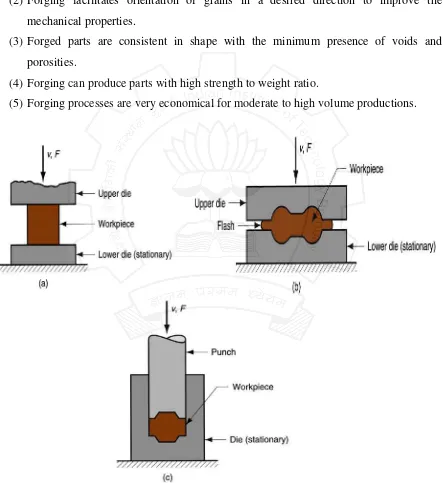

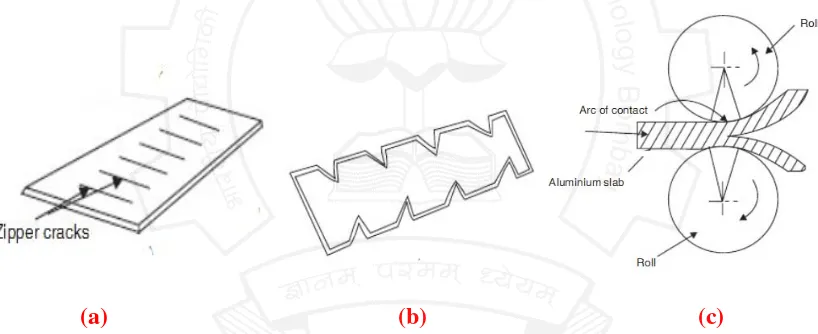
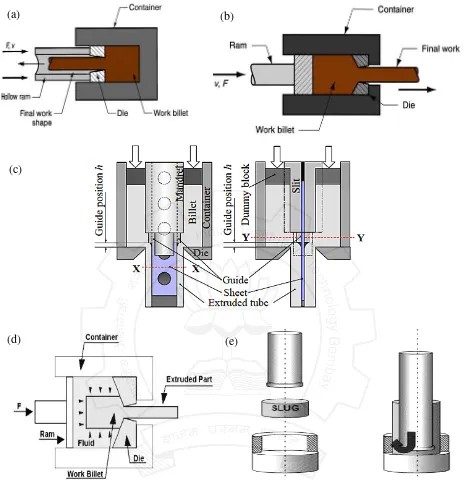
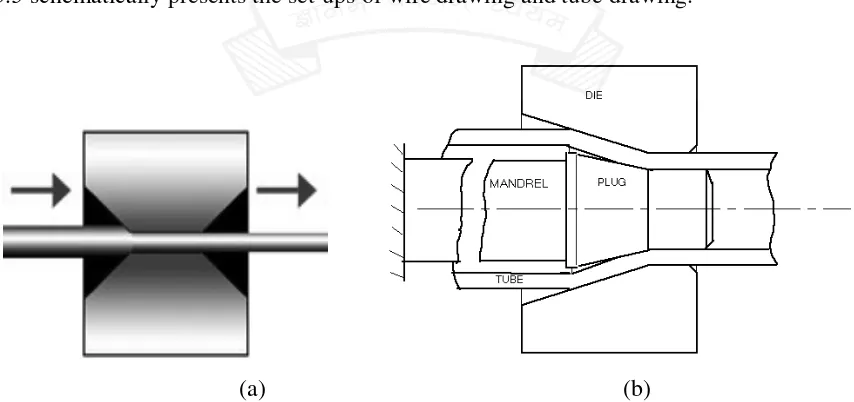
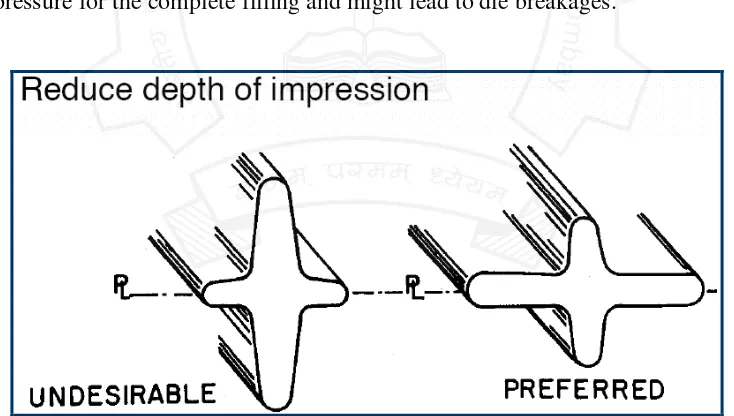
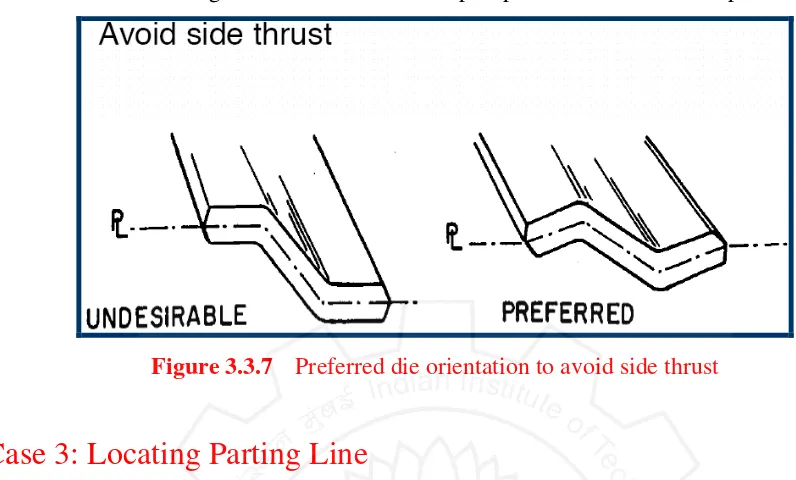
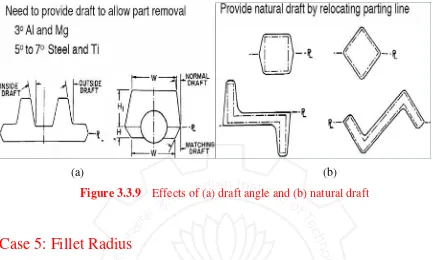
![Figure 3.3.11 Effect of roll deflection [4]](https://thumb-ap.123doks.com/thumbv2/123dok/2949602.1704127/14.595.115.482.191.571/figure-effect-of-roll-deflection.webp)